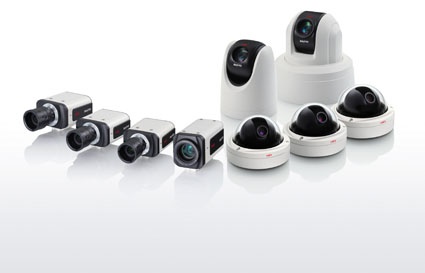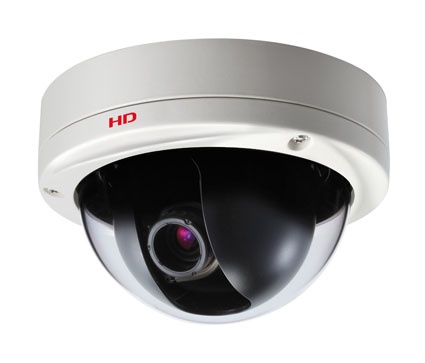The Success of HD?
Whilst high definition cameras have been available for some time, the remarkable quality of the images which can be captured by the latest generation of Full HD cameras do truly ne...



Whilst high definition cameras have been available for some time, the remarkable quality of the images which can be captured by the latest generation of Full HD cameras do truly need ‘to be seen to be believed. At long last the CCTV industry can offer cameras, which if installed correctly, can consistently deliver evidence grade video. Sanyo can claim to be the first major CCTV brand to introduce a complete range of Full HD cameras. There are nine models in the range including fixed cameras, a zoom camera, vandal resistant domes and PTZ cameras.
You might expect Sanyo to want to immediately take advantage of its head start by embarking on a major promotional campaign to persuade the market to ‘buy now'. It has chosen, however, to take a longer term view and has embarked on a strategy which recognises that sustained success will come from embedding qualified business partners across Europe who share Sanyo's enthusiasm for the remarkable new technology built into the nine Sanyo Full HD cameras. Equally important, however, is a belief that these business partners need to be ready, willing and able to take on board the required level of sales and technical training to ensure Sanyo's Full HD cameras meet, if not exceed, the end users' expectations.
Training Is Key
"Our training programme will play a major role in underscoring Sanyo's position as the authority and market leading manufacturer of Full HD cameras," said David Hammond, European Sales Manager for the CCTV division of Sanyo. "The CCTV industry has been known to introduce new technologies with a great deal of fanfare only to find that consultants, installers and end-users are not too quick to consider changing from what they have become used to. Part of the reason for this is that there is a reluctance to recommend or install products incorporating new technology when the implications of doing so are not fully understood."
David Hammond cites Video over IP as a typical example of new technology which was much hyped over ten years ago as ‘the next big thing' but is only now being widely accepted as a method of transmission which, depending on the application, can offer great benefits compared to using traditional coaxial cabling. "Part of the reason why it has taken so long for IP/network based security solutions to be considered as a matter of course is the fear factor," adds David Hammond. "By this, I mean the lack of knowledge among installers as to how to design the system and how to speak the language of network managers."
David Hammond and his colleagues at Sanyo are determined that the pace at which Full HD camera technology is utilised by end-users is not affected by the lack of training by all who are involved in the sales channel, i.e. installers, distributors and third party influences such as consultants.
Sanyo have made a substantial investment in developing a Full HD technology education programme which is made up of four separate training modules. Each module is tailored to cater for the specific requirements of different types of stakeholders, i.e. end-users, consultants, installers/system integrators and distributors and comprehensively covers how to design, install and commission a CCTV system based around Full HD camera technology.
Ongoing Training
The training modules have been designed to be interactive in that after an initial classroom training session, the trainer will have the facility to stay in contact with the ‘student' to ensure that he/she has retained the required level of knowledge and is aware of any new product or technological developments.
"We want to ensure that the value of participating goes way beyond having a framed certificate to put up on an office wall. The success of this exciting new technology rests to a great extent on those involved in the system design, selling and installation process fully understanding all the issues. This includes being kept up to date with any changes to the products and installation techniques, as well as recording and networking options. It is intended therefore that certificates issued at the completion of a training module will have an expiry date which can be extended as the respective student continues to participate in the ongoing interactive training programme.
True Partnership
"Manufacturers who appoint installers as part of their ‘authorised network' quite often expect those installers to sign up to a binding commercial agreement which might even include a commitment to purchase certain levels of products each month. Sanyo do not intend to place any such conditions on suitably qualified installers or system integrators becoming a Sanyo business partner. We believe that the responsibility is on us to provide the best possible pre and post sales support services to complement the superb performance of our Full HD cameras and that by doing so, we will earn the loyalty of our business partners.
The only commitment we are looking for is ongoing participation in our training programme. We strongly believe that this will give sales personnel for installers and system integrators, as well as distributors, the confidence to recommend Full HD cameras to their customers on every possible occasion. Most importantly of course is that the training programme will equip technicians with all the information they need to correctly install and commission the cameras to deliver the maximum benefits to customers."
Picture Quality and Storage Capacities
One of the key areas which the training module addresses is how to record and store the large file sizes generated by a Full HD camera. The quality of the images that can be captured by Full HD cameras is impressive compared to even the very latest analogue or standard resolution IP cameras but there is a price to pay in terms of file sizes of the images. Typically, a standard camera will create images which have a file size of 0.3MB based on a resolution of 640x480, whilst images (1920 x1080) from a Full HD camera are 2MB in size. There is clearly therefore going to be a need for a large number of DVRs and backup storage capability if there is a requirement to record and store video from a large number of cameras. The cost of this could be prohibitive and prevent customers from the opportunity to capture the superb evidence grade images which can be generated by Full HD cameras.
The solution is simpler and requires a lower investment than you may think. It involves the use of H.264 compression and the installation of servers or NVRs instead of DVRs. For inexperienced installers in IP/network methodology, the thought of installing a server may seem daunting, but it is not as complex as it may first seem. The financial savings which can be achieved compared to the cost of recording onto a DVR is substantial and as a result the simultaneous recording of video from a large number of Full HD cameras becomes affordable.
A full HD camera image is made up of approximately seven times more pixels than that from a standard CCTV camera and as a result we can expect to see picture quality similar to what we have come to expect from our HD TVs. Do CCTV operators need to observe and record Full HD images in real time, all of the time? Even in VGA mode, Full HD cameras deliver very high quality images.
A further way to reduce storage requirements may therefore be to only record Full HD images upon Alarm, including motion detection, with images recorded in VGA mode at all other times. This would ensure that evidential quality video is available when required and would enable operators to simultaneously monitor live images in Full HD mode. This functionality is provided by the latest Dual and Quad Streaming technology which adds to the flexibility of viewing and recording IP Streams.
Another key aspect of the training programme will be to ensure that there is no confusion over the terminology in order to ensure that Sanyo cameras are neither under nor over specified in terms of what they can deliver. The training courses cover this particular subject in considerable depth but here is some basic information which will be imparted to people who participate in one of the training modules.
HD and Megapixel
All HD cameras are megapixel but only some megapixel cameras can be referred to as HD. A camera which generates images comprising one million pixels or more, can be described as a megapixel camera. However, for a camera to be described as an HD camera, it has to comply with the universally accepted HD standard and a key component of the standard is that a camera must have a display ratio of 16:9.
It therefore follows that even if a megapixel camera can generate images comprising two million pixels or more, it still cannot be referred to as an HD camera unless it has a 16:9. aspect ratio. Why is this relevant or important to the electronic security industry? Very simply, the 16:9 aspect ratio allows users to see a much wider field of view compared to the traditional 4:3 aspect ratio and because all HD cameras are megapixel, users can then zoom into a small part of an image to see close up details of an object, person or incident.
Facts and Figures
Here are some useful facts and figures which you might find useful when looking to specify cameras for applications where evidence quality images may be required.
- A typical VGA image has a resolution of 640 x 480 = 0.3 million pixels
- A 4CIF image has a resolution of 704 x 576 = 0.4 million pixels
- A D1 image has a resolution of 720 x 576 = 0.41 million pixels
- An HD image comprises 1280 x 720 pixels = 1 million pixels
- A Full HD image comprises 1920 x 1080 pixels = 2 million pixels
Until recently, high definition cameras were considered to be highly priced niche products. The price/performance ratio has, however, improved substantially over the last twelve months and it is now a viable proposition for Full HD cameras to be considered for most CCTV projects. Sanyo believe that the investment it has made into developing its training programme will be more than justified by giving all parties involved the confidence to fully embrace this exciting and innovative technology.
Business Partner
Sanyo Sales & Marketing Europe GmbHStahlgruberring 4
81829 München
Germany
most read


Assa Abloy's battery-powered Aperio KL100 secures lockers
Boost workplace security and operational flexibility by securing more than just doors.

Integrated and Futureproof: Traka’s Next Chapter
Interview with Stefni Oliver on Traka’s Vision for the Future

Security management, building security & perimeter protection: the winners of category E at the GIT SECURITY AWARD 2026
GIT SECURITY AWARD 2026: Security management, building security & perimeter protection - an overview of the most innovative solutions

Is Your Venue Ready for Martyn’s Law?
Martyn’s Law demands stronger security by 2027. Is your venue prepared to protect and respond?






